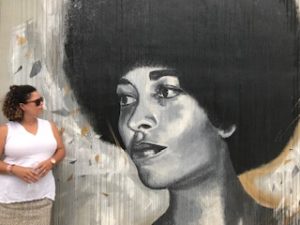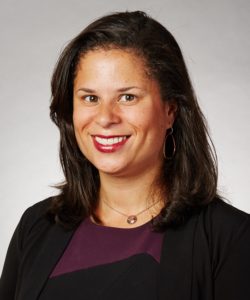By Joanna Trotter, Senior Program Officer, The Chicago Community Trust
As a Chicagoan visiting Buffalo, N.Y. for my first time with my amazing PLACES colleagues, I was surprised at how familiar this smaller urban city felt to me. Despite the size difference, it in many ways felt like home. Was it the shared Great Lakes identity? Or was it the similar migration history? Was it the common industrial and transportation past? Maybe. But even more so, what I identified with in Buffalo was the shared long-term and highly visible impacts of racial and economic inequality.

Chicago and Buffalo are linked by an unseemly legacy of racial segregation. According to a variety measurements and sources, both cities are ranked in the top 10 most segregated cities in the United States. In 2017, the Metropolitan Planning Council (MPC), in partnership with the Urban Institute, went a step further in Chicago to look at our entire region. The city of Chicago is well known for its segregation. However, what MPC found is that as we have continued to grow as a region, our segregation patterns held up as we sprawled into seven counties, making us the fifth most economically and racially segregated region in the nation. The Cost of Segregation study quantified that living separately costs the Chicago region $4.4 billion in lost wages, $8 billion in Gross Domestic Product, over 80,000 young people the bachelor’s degree they need to fulfill their potential, and hundreds of lives cut short by the violence that unequal opportunity and isolation produces.
As I toured Buffalo, I observed familiar signs of uneven economic recovery, where investment was increasing in some communities, while other neighborhoods are still devastated by foreclosure. It shows up in a similar tale of two cities paradigm where displacement is not predominately characterized by gentrification like you may find in areas like Los Angeles and San Francisco, but instead is a combination of heightened market pressures is some communities and an outmigration of people of color due to limited opportunities in others. In Buffalo, we learned that a full two-thirds of the black and Latinx population lives in high poverty neighborhoods. We learned that the average white household income is almost $20,000 more annually than the average household of color and white homeowners enjoy over 2.5x the home value of homeowners of color.
Chicago and Buffalo are also both losing population, a rarity in US urban cities today. Buffalo dropped from the 580,000 people in the 1950s to 261,000 today. In Chicago, we’ve been able to ascribe our loss to an exodus of people of color. From 2000 to 2010, we lost just short of 200,000 people. Almost ninety percent of this loss is attributed to African American outmigration. We are hemorrhaging our diversity and the small population uptick Chicago experienced recently is due to an in-migration of higher-wage and less-diverse residents.
Taking this all into consideration, a conclusion one would logically draw is that to address segregation, you must increase integration. However, the Cost of Segregation study spurred our region to have open and difficult conversations about segregation, racism, and integration. It became apparent that we can no longer frame the solution to segregation simply through integrating communities, schools, or neighborhoods. Equitable policies and practices must take precedent.
I live in a racially segregated African American community in Chicago: South Shore. South Shore holds a rich history, boasts direct proximity to the beautiful Lake Michigan shoreline, is economically diverse, has unmatched architecture, and provides a 15-minute comfy commuter rail ride to downtown Chicago. Michelle Obama grew up in South Shore and she and Barack were married in this neighborhood. Even more importantly, South Shore residents have been working for decades to support investment. However, national retailers continue to overlook this community. Absentee property owners sit on vacant lots and hold vacant buildings hostage. Unscrupulous investors continue to prey upon our dense multifamily housing stock with investments schemes that hold buyers and renters hostage. Just this summer, our community was the epicenter of yet another police shooting of a young African American man. So, to approach a neighborhood like South Shore and posit integration as the solution neglects to directly confront the fact that segregation in itself is not the problem. For a community like mine and East Buffalo, why should it take white people to move in to receive adequate investments in our schools, commercial investment in our business corridors and better policing practices?
No, the problem with integration as a solution is it lets structural racism off the hook. We must directly confront inequitable public and private practices that become all too efficient and endemic in segregated communities. And, we must cease problematizing communities of color and not questioning segregated white communities, which is often what integration approaches propose or insinuate.
While Chicago is a big city that often prides itself on civic engagement and boldness, we have a lot to learn from Buffalo. During our stay, the PLACES Fellows learned about Buffalo’s Racial Equity Roundtable, which is bringing together stakeholders across sectors to drive equitable outcomes in the areas of education and job readiness, criminal justice and safety, quality of life and neighborhoods, and income and wealth. They have effectively made the case for why racial equity must be at the center of Buffalo’s resurgence and are not only convening, they are driving change by holding each other accountable for quantifiable targets and real outcomes all aimed at closing equity gaps. They have influential leaders at the table, from the mayor to CEOs, to heads of anchor institutions. And while I left the presentation curious about the role of grassroots leaders and residents in roundtables such as this, I also was envious of the type of leadership Buffalo has at the table committed to this type of change.
In Chicago, we are seeing movement and even recently our Cook County Board President has prioritized racial equity in her new policy roadmap. And with our incumbent mayor announcing his intent not to run for reelection, we may have an opportunity to influence the next mayor’s policy platform. We also enjoy a committed and collaborative philanthropic community and can boast that we now have six major area foundations now led by people of color; a change that has taken place in just under five years. Are the stars aligning for us? I can only hope.
Catch up on our last Going PLACES blog here.
About the Author
 Joanna Trotter is the senior program officer in economic and community development for The Chicago Community Trust. Trotter leads grant making that supports regional and community-based organizations forwarding equitable development. Prior to joining the Trust, Trotter served as director of neighborhood development for the University of Chicago’s Office of Civic Engagement where she guided and coordinated University investments largely in the Woodlawn and Washington Park communities. Trotter also spent ten years forwarding the Metropolitan Planning Council’s community building work across the seven-county Chicago region. By providing technical assistance and support to communities, Trotter worked to inform and increase opportunities consistent with MPC’s broader policy goals of creating a more equitable, sustainable and competitive region, such as enhancing local connections between housing, employment and transportation. In 2013, she was promoted to vice president of programs, directing MPC’s community development activity and providing leadership to the organization as whole as part of MPC’s management team. Prior to MPC, Trotter was the commercial district planner for DevCorp North (now the Rogers Park Business Alliance), the community and economic development organization in Rogers Park. Trotter serves as the co-chair of the Urban Land Institute (ULI) Public Policy Committee and is on the board of the Quad Communities Development Corporation. Trotter earned a M.A from the University of California Los Angeles in Urban and Regional Planning.
Joanna Trotter is the senior program officer in economic and community development for The Chicago Community Trust. Trotter leads grant making that supports regional and community-based organizations forwarding equitable development. Prior to joining the Trust, Trotter served as director of neighborhood development for the University of Chicago’s Office of Civic Engagement where she guided and coordinated University investments largely in the Woodlawn and Washington Park communities. Trotter also spent ten years forwarding the Metropolitan Planning Council’s community building work across the seven-county Chicago region. By providing technical assistance and support to communities, Trotter worked to inform and increase opportunities consistent with MPC’s broader policy goals of creating a more equitable, sustainable and competitive region, such as enhancing local connections between housing, employment and transportation. In 2013, she was promoted to vice president of programs, directing MPC’s community development activity and providing leadership to the organization as whole as part of MPC’s management team. Prior to MPC, Trotter was the commercial district planner for DevCorp North (now the Rogers Park Business Alliance), the community and economic development organization in Rogers Park. Trotter serves as the co-chair of the Urban Land Institute (ULI) Public Policy Committee and is on the board of the Quad Communities Development Corporation. Trotter earned a M.A from the University of California Los Angeles in Urban and Regional Planning.
